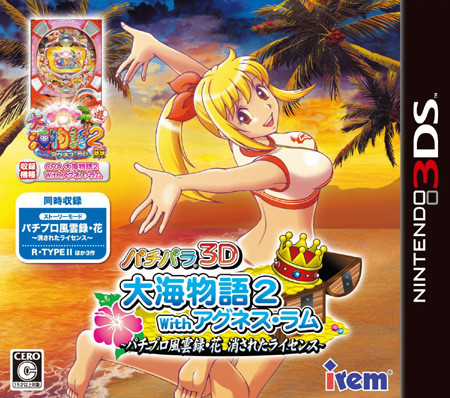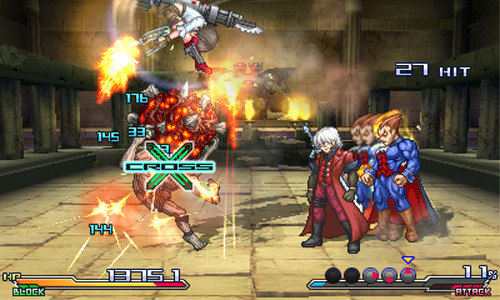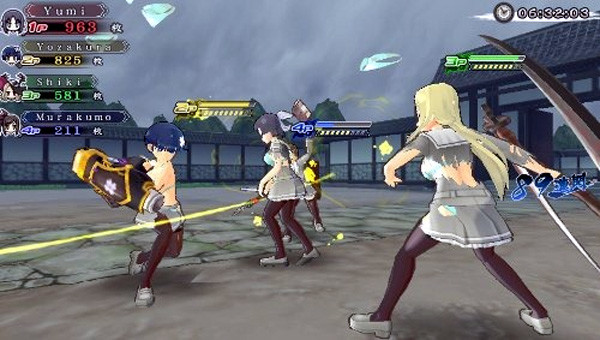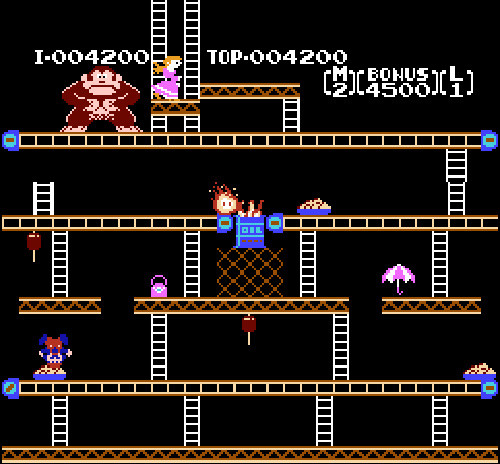- remind me tomorrow
- remind me next week
- never remind me
The X Button
Sea Change
by Todd Ciolek,

As usual, this column covers a few imports from the past month. Yet there's one game that's relevant not because of what it is, but because of what it represents: the demise of a once-notable developer.

I've written before about Irem's abrupt exit from the game industry: how they canceled Disaster Report 4 and Steambot Chronicles 2 after the Tohoku earthquake and simply didn't start up again. In an interview this summer, ex-Irem director Kazuma Kujo confirmed that the company went back to its original calling: slot machines and slot-machine video games.
This means that Irem's only games will be like last month's PachiPara 3D: Ooumi Monogatari 2 with Agnes Lum, an unremarkable pachinko-slot simulation. Sure, it has a story mode and a few hidden Irem Game Boy games, but it's a distant cry from the company that made R-Type, Undercover Cops, and Ninja Baseball Bat Man.
A more troubling question lingers. Is Pachipara 3D a vision of what awaits other mid-range companies? With the Japanese game industry rapidly bifurcating into big-budget titles and lower-key otaku niches, will more developers give up on genuine games and turn to simple, marginally profitable puffery? Will we one day see Treasure and G.Rev and Cave and Neverland and tri-Ace all making naught but pachinko-slot games shilled by bikini models? And then what shall we do in that world gone mad?
NEWS
PROJECT X ZONE IS STUFFED FULL A WEEK FROM RELEASE
It's high time we checked back in with Project X Zone, the strategy-RPG crossover of numerous CAPCOM, Namco Bandai, and Sega franchises. The game seems to add new characters every week, but it arrives on the Japanese 3DS in about eight days, and perhaps we're looking at the final roster.

As it stands, the game draws in Kurt Irving, Riela Marceris, and Imca from Valkyria Chronicles; Gemini Sunrise, Ichiro Ogami, Sakura Shinguji, and Erica Fontaine from Sakura Wars; Akira and Pai from Virtua Fighter; Cyrille and Toma from Shining Force EXA; Ulala from Space Channel 5; Vashyron, LEANNE, and Zephyr from Resonance of Fate; That Bruce Willis Lookalike (OK, his name's Bruno Delinger) from Dynamite Cop; Rikiya from Zombie Revenge; Bahn from Fighting Vipers; Chris Redfield and Jill Valentine from Resident Evil; Dante and Lady from Devil May Cry; Dimitri, Morrigan, and Hsien-Ko from Darkstalkers; X, Iris, and Zero from Mega Man X; Arthur from Ghosts 'N Goblins; Tron Bonne and her Servbots from Mega Man Legends; Ryu, Ken, and Chun-Li from Street Fighter; Frank West from Dead Rising; Devilotte from Cyberbots; Batsu from Rival Schools; Yuri, Flynn, and Estelle from Tales of Vesperia; Jin, Xiaoyu, and Alisa from Tekken; Kite, Aura, and Black Rose from .hack; KOS-MOS and T-elos from Xenosaga; Sanger Zonvolt from Super Robot Wars; Soma, Lindow, and Alisa from Gods Eater Burst; Valkyrie from The Legend of Valkyrie; Haken Browning and Kaguya Nanbu from Super Robot Wars Endless Frontier; and Neneko and Neito from Yumeria (yes, that dating-sim that ADV once released in anime form). Also on hand are Reiji and Xiaomu, the original characters from the last big game-company crossover, Namco X CAPCOM. They join Project X Zone's new faces, Kogoro Tenzai and Mii Koryuji.

Mind you, those are just the heroic characters. There's a similar lineup of “rival” characters: Phantom from Endless Frontier; the Vajra from Gods Eater Burst; Skeith from .hack; Heihachi from Tekken; Riemsianne from Shining Force EXA; AYAME and Prelude from Sakura Wars; Selvaria Bles from Valkyria Chronicles; Astaroth from Ghosts 'N Goblins; Vile from Mega Man X; Juri and Seth from Street Fighter; Nemesis from Resident Evil; and Lord Raptor and Jedah from Darksta…wait, when was Lord Raptor a villain? T-elos and Devilotte are on the good guys' list, but Raptor and his harmless zombie-rocker ways are bad? Strange. Anyway, there are also some original villains in Duwei Frabellum and her two beast-man bodyguards.

This voluminous cast is the main attraction of Project X Zone, as the characters quibble in cutscenes and gather together in strategic battles. Confronting an enemy brings up a side-view battle scene, wherein characters join together and pull off familiar attacks. As in Namco X CAPCOM and Endless Frontier, special moves are accompanied by brief animated portraits of the characters. With any luck, it'll show a little more challenge than the pushover approach of Namco X CAPCOM, and perhaps we'll see some deadline additions from Tech Romancer, Mappy, or Last Bronx before the game ships.
SENRAN KAGURA: SHINOVI VERSUS IS NOW A DYNASTY
Some people expected Senran Kagura to be a one-game deal when it hit the 3DS last year. It was a basic brawler structured around the 3-D cartoon breasts of its frequently undressed ninja-girl heroines and their rivals. How much could Marvelous Interactive really get out of that idea? Well, in today's anime-game industry, the answer is “a sequel, several different manga titles, an anime series, and even a line of suggestive ice cream dishes at an Akihabara café.” Yes, Senran Kagura is a success, and the latest game sets its sights on territory recently explored by popular anime, namely the Dynasty Warriors school of open-field action.

Senran Kagura: Shinovi Versus hurls the original game's five lead characters and their antagonists into spacious battlefields littered with presumably stupid enemies. Ten new playable heroines will join the cast, and the first team to be introduced is the delightfully named Death Cram School lineup of the elegantly attired Yumi, pastel-colored minori, oni-masked Murakumo, hard-punching Yozakura, and Shiki, who appears to be a pirate dominatrix of some kind. The game allows four-player battles over Wi-Fi, and the characters' already revealing outfits are just as easily shredded this time around. It's headed for the Vita (hence the “Shinovi” part) next February, right around when the anime series should arrive. If Marvelous has its way, Senran Kagura will never end.
GET DONKEY KONG'S CEMENT PIE FACTORY FOR FREE
The second level of Donkey Kong is a bit contentious, and not just because fans argue over whether its conveyor belts hold pies or cement-filled pans. A remarkably faithful version of Donkey Kong was brought to the Famicom in 1983 (and later to the NES, of course), but it was missing that familiar cement/pie factory stage. This wasn't such a big deal, since it was the weakest of the game's four recycled levels. However, Nintendo surprised some people in 2010 by releasing Donkey Kong: Original Edition with a European Wii bundle. This Original Edition is essentially the NES version of the game with the addition of that long-lost pie/cement facility.

Perhaps in response to complaints about the game's European-only release, Nintendo plans to give away Donkey Kong: Original Edition to any Club Nintendo members who download one of the following five games from the Nintendo eShop: Art Academy: Lessons for Everyone, Crosswords Plus, Paper Mario: Sticker Star, Professor Layton and the Miracle Mask, and Style Savvy: Trendsetters. As long as you download the game by January 6 (and put your Club Nintendo account on your 3DS), you'll get Donkey Kong's cement pies. And really, we were all going to buy Style Savvy: Trendsetters anyway, weren't we?
IMPORT ROUNDUP: SEPTEMBER
KOKUGA Developer: G.Rev
Developer: G.RevPublisher: G.Rev Platform: Nintendo 3DS Much like Code of Princess (see below), G.Rev's Kokuga has a clear connection to Treasure. Hiroshi Iuchi, Kokuga's director, also helmed Ikaruga, Gradius V, and Radiant Silvergun. He even pulled off design work on numerous other Treasure games (and Time Warner's highly rare Psychic Assassin Taromaru). Kokuga isn't quite the same sort of shooter as Ikaruga, though; instead of a vertically scrolling game, it's a multi-directional deal wherein a tank scuttles across neon-hued levels and blasts everything. Yet Iuchi's style is clearly in effect, and fans of Treasure shooters will recognize it as they weave through enemy fire or duck behind blocks to avoid screen-sweeping laser beams. Even the soundtrack has the staccato beats of an Ikaruga score. Kokuga also presents an unexpected system of power-ups. Players are issued 20 random cards at the start of every stage, and each brings some different boost or new weapon to the tank's arsenal. The cards are activated through the lower 3DS screen while dodging and strafing on the upper one, and a touch of strategy's involved when it comes to using a power-up. In an old-school touch that recalls the Darius series, Kokuga arranges its levels in a pyramid, allowing the player to choose a path to the final stage at the top. That journey isn't a lonely quest, either, as up to four players can tackle a stage together. Import Barrier: While there's little in the way of language issues, the 3DS is still region-locked. Chances of a Domestic Release: No announcements have been made, though the game seems a quick and easy localization. If Code of Princess can find its way here, perhaps some Western publisher will smile on Kokuga.
|
LOST HEROES Developer: Banpresto
Developer: Banpresto Publisher: Banpresto Platform: Nintendo 3DS, Sony PSP Namco Bandai's Compati Hero series is the Taco Bell of the Japanese game industry, forever finding new ways to mix the familiar ingredients of Gundam, Ultraman, and Kamen Rider. It's a recipe that started with the original SD Battle Ozumo on the Famicom and continued through seven different Great Battle games of various genres. As the latest in this franchise, Lost Heroes taps into the recent trend of dungeon hacks appearing on the 3DS and PSP. The game's headlined by Nu Gundam, Kamen Rider Den-O, and Ultraman Mebius, but they're just the lead acts in a lineup that features Ultraman Taro, Kamen Rider W, Z Gundam, Ultraman Zero, Kamen Rider BLACK RX, Wing Gundam Zero, and more from an enormous cast. The same goes for the creatures that the heroes face within dungeons, as they range from beefed-up Zaku units to towering Ultraman monsters. Lost Heroes adopts the traits of many dungeon hacks: randomly generated labyrinths, steep difficulty, and a first-person perspective in battle. However, this is also a game all about promoting the toys and TV shows of three different long-lived media brands, and Banpresto isn't going to let genre standards get in the way. While most first-person dungeon crawlers don't show the characters attacking during combat, Lost Heroes is careful to switch perspective so players actually see the super-deformed versions of Z Gundam and Ultraman pulling off grand-scale moves straight out of their respective franchises. Lost Heroes even breaks with convention by letting the characters hop into a Ride Machine and drill through walls. There isn't much difference between the PSP and 3DS version of Lost Heroes, though the former has customized soundtracks and the latter reveals new items through the 3DS unit's StreetPass mode. And there's one other distinction… Import Barrier: The 3DS version's region-locked, but the PSP one isn't. And while there's a bit of language barrier, any stalwart fan of Kamen Rider or Gundam can work out the names and commands. Chances of a Domestic Release: None too likely, particularly since the latest Gundam and Kamen Rider shows haven't even arrived in North America. And Ultraman? Best not to ask. |
YS CELCETA: SEA OF TREES Developer: Falcom
Developer: Falcom Publisher: Falcom Platform: PlayStation Vita It's easy to accuse Falcom of wallowing in Ys ports and remakes. They've brought the first two Ys games just about everywhere, and they substantially refashioned Ys III into The Oath in Felghana. But here's the thing: Falcom's never really made an Ys IV. There were two different versions of the title back in the day, but neither was directly crafted by Falcom. Hudson Soft and Alfa System made Ys IV: The Dawn of Ys for the PC Engine, Tonkin House made Ys IV: Mask of the Sun for the Super Famicom, and Taito even remade Mask of the Sun for the PlayStation 2. So Ys Celceta: Sea of Trees is Falcom's first real crack at the fourth part of their own flagship series. Replacing all previous Ys IVs in terms of canon, Celceta: Sea of Trees finds red-haired hero Adol stricken with amnesia. He wanders around the kingdom of Celceta, uncovering mysteries about ancient gods and stirring horrors. While it retains much of the original Ys IV's cast and storyline (right down to a trio of villains led by a sorceress named Bammy), Celceta also delves into Adol's history as he rebuilds his memories, shedding a little light on the usually blank hero. In gameplay, Ys Celceta takes after Ys Seven in letting the player switch between three different party members, with the other two following the lead and helping in battle. Adol remains the player's prime avatar in this arrangement, but he's joined by the knife-tossing Carna, the fistfighter Dulen, the mage Canlilika, and the spear-wielding Ozma (Adol's usual sidekick Dogi is apparently absent, at least for the game's initial leg). Their various attacks let Adol discover new routes, adding a vaguely Metroid-ish cast to exploration, and there's even a bracelet that shrinks the cast down. Celceta also benefits from a pace quicker than the already fluid Ys Seven, and the Vita seems to handle it all very well. Import Barrier: The Vita's region-Free! and the gameplay's easy to grasp, but... Chances of a Domestic Release: It's very likely that XSEED Games (or perhaps some other publisher) will grab Celceta once the dust has settled. Nothing's nailed down yet, but if you've waited eighteen years for a Falcom-made Ys IV, you can wait a little longer for an English version. |
NEXT WEEK'S RELEASES
CODE OF PRINCESS  Developer: Studio Saizensen/Empty/Agatsuma Entertainment
Developer: Studio Saizensen/Empty/Agatsuma EntertainmentPublisher: Atlus Platform: Nintendo 3DS MSRP: $39.99 There's a reason Princess Solange looks so embarrassed on that cover. Though the Code of Princess logo obscures it, she's wearing armor too scant even to be called a bikini. This is the work of frequently CAPCOM-affiliated artist Kinu Nishimura (who perhaps reused her Pallas Athena design from the canceled War of the Grail just a tad). So much emphasis was placed on Solange's looks and stainless-steel pasties that she was turned into an expensive statue before Code of Princess was even announced for the 3DS. All of this suggested a game designed for image over substance, but then someone noticed that Code of Princess' gameplay resembled that of Treasure's classic brawler Guardian Heroes. This was no accident. The staff behind Code of Princess includes Tetsuhiko “Han” Kikuchi and Masaki Ukyō, both of whom worked on Guardian Heroes and other Treasure titles. And with that, Solange didn't have to be quite so embarrassed. Code of Princess progresses a lot like any given belt-scrolling game, but it allows characters to leap between three different planes, as in Guardian Heroes. It may seem more limiting than the norm, but the idea allows for different strategies and a focus similar to a fighting game. Solange, who's off on one of those quests that dutiful royals so often undertake, is joined by the agile thief ALI-Baba, the elf singer Allegro Nantabile Cantabile, the blind samurai Tsukikage, the heavyweight fighter Master T Drakkhen, the armored nun Helga Wilhelmina, the zombie sorceress Lady Zozo, the Pharaoh-like merchant cat Marcopolis Neko, and a further assortment of weirdos. In fact, 52 characters are playable in the game's versus mode, a number that includes monsters as well as allies. Four-player cooperation is also offered during the central quest. Code of Princess is clearly not a game to repel accusations of pervasive sexism, but its deeper strains seem dedicated to keeping a classic spirit alive.
|
DISHONORED Developer: Arkane Studios
Developer: Arkane Studios Publisher: Bethesda Softworks Platform: PC/PlayStation 3/Xbox 360 MSRP: $59.99 Dishonored might be a high-profile release, but some still worry it'll be overlooked simply because it's not tied to any popular series. In a way, it is: the game's staff at Arkane also worked on Bioshock 2, Deus Ex, and Half-Life. Those titles influenced Dishonored more than a little. For one thing, Dishonored's futuristic Victorian city seems like a more colorful and interesting take on the draconian urban realms of Half-Life. Dishonored's Dunwall mixes architecture from various centuries, then draws on a similar spectrum of social ills, from plagues to fascist oppression. It's a place where “Tallboy” sentries patrol the streets on mechanized stilts while gateways vaporize any lesser-caste residents who wander into the wrong neighborhood. It's here that imperial bodyguard Corvo Attano is framed for murder, and his vengeance requires a long journey through the city. Corvo pulls this off with a first-person blend of subterfuge and violence, sneaking around one moment and viciously stabbing a guard the next. He has his share of conventional firearms and sharp objects, but there's more fun to be had in our antihero's supernatural abilities. They range from x-ray vision and teleportation to more arcane matters, such as possessing other characters, stopping time, or summoning up a tide of rats to devour enemies (and perhaps create a reference to 1984). As in Deus Ex and the Thief titles, it's up to the player to choose a path of bloodshed or stealth, though the game doesn't explicitly track Corvo's moral compass by his decisions. Instead, Corvo's methods are judged by other characters, who might not aid him if he causes too many civilians deaths. So Dishonored seems to stand apart from its influences, and not just because of its breakthroughs in rat-based gameplay.
|
POKEMON BLACK/WHITE 2  Developer:GAME FREAK
Developer:GAME FREAK Publisher: Nintendo Platform: Nintendo DS MSRP: $34.99 As a fan of the Neo Geo Pocket Color, I will forever hold a grudge against Pokemon. Of course, the Neo Geo Pocket Color died entirely because SNK was bought and eviscerated by pachinko powerhouse Aruze, but at the time it was easy to blame the success of Pokemon and the Game Boy Color for taking all the attention. That success continues with each new color-coded Pokemon title—or in this case, a sequel to a color-coded Pokemon title. Pokemon Black 2 and Pokemon White 2 return to Unova, a realm that resembles American cities a little more than the Japanese landscapes of previous Pokemon titles. Set two years after the original Black/White story, the sequel again brings the player's avatar face to face with the conniving Team Plasma, along with another round of Gym Leaders to battle for their all-important Badges. There's an arc or two about power struggles and legendary Pokemon along the way, for those who follow the mythos of creatures called Tornadus, Keldeo, and the all-new Black/White Kyurem. Naturally, the real point of the game lies with the multitude of Pokemon and the various ways of sending them into battle. Black/White 2 returns several familiar older creatures to the 300-strong lineup, with the beloved Psyduck being the most notable reintroduction. As for human Pokemon veterans, many of them appear in the game's Pokemon World Tournament, which pits the player against older characters like Misty and Brock. The games also feature a new mode called Pokestar Studios (the Japanese name “Pokewood,” was apparently too suggestive), in which players make films by staging battles and choosing several options from a script. Devoted players will also note many little changes to locations from the first Black/White games, including redesigned dungeons and new appearances. And this time, there's no doomed underdog console for Pokemon fans to ignore.
|
discuss this in the forum (17 posts) |
this article has been modified since it was originally posted; see change history